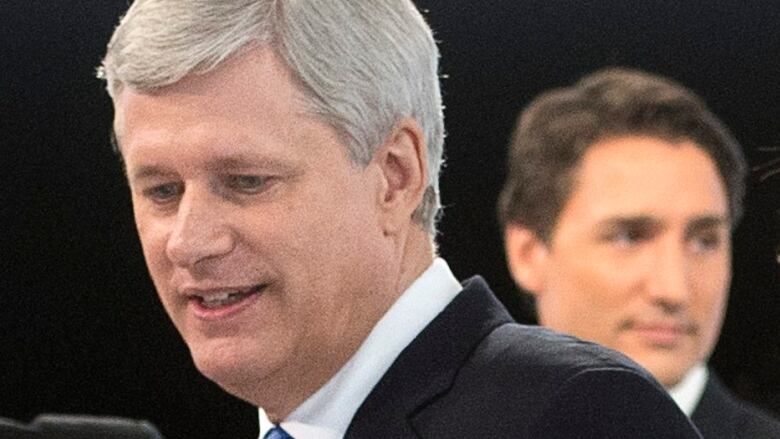Poll Tracker: Conservatives, Liberals trading lead in muddled polling race
Is the way polling is being conducted behind the discrepancies?

Most polls continue to show a close race between the Liberals and Conservatives in national voting intentions, and virtually all are clear that the New Democrats are running in third.
But could methodology be behind the recent disagreement in the polls?
- Poll Tracker:Follow the latest numbers
- Podcast:Subscribe to ric Grenier's Election Pollcast
The CBC Poll Tracker shows the Liberals and Conservatives virtually tied, with 32.5 and 32.3 per cent support, respectively. The New Democrats stand at 25 per cent, followed by the Greens at 4.7 per cent. The Bloc Qubcois has increased its support to 20.4 per cent in Quebec.
The overall trends continue to suggest the NDP is dropping in support. Compared to a week ago, the NDP finds itself 2.7 points lower in the Poll Tracker. The Liberals are up by a more modest1.7 points, while the Conservatives increased by 0.5 points.
The Conservatives still have the advantage in the seat count, thanks to how their vote breaks down regionally. They would likely win 109 to 155 seats if an election were held today, with the Liberals set to take 91 to 130 seats and the NDP winning between 75 and 108 seats. The Bloc could win between one and eight seats, and the Greens one.
But while the trend line is clear on average, the polls continue to tell two different stories.
Who's calling?
Thetwo sets of narratives in the polls that emerged last week appears to be continuing: one shows a close race between the Liberals and Conservatives, and the other shows the Conservatives in a dominant position. What is behind this discrepancy?
Mode of contact with voters does seem to be one source of disagreement.
Polls conducted via interactive voice response (automated telephone calls) are showing much stronger Conservative results, while most online polls and the only live-caller telephone tracking poll is showing the two-headed race between the Tories and the Liberals.
- Range ofthree recent IVR polls (EKOS, Forum,Mainstreet):Conservatives 33-37per cent, Liberals 27-29per cent, NDP 24-28per cent.
- Range of five recentonline polls (Abacus, Angus Reid Institute, Innovative, Ipsos Reid, Lger):Conservatives 29-34per cent, Liberals 27-32per cent, NDP 26-29 per cent.
- Range of recent telephone polls (Nanos):Liberals 32-36 per cent, Conservatives 31-33 per cent, NDP 23-27 per cent.
There is general consistency in the numbers for the New Democrats, with the IVR polls posting higher Conservative results and the Nanos telephone polls posting higher Liberal results. The online polls generally split the difference, with all but the Angus Reid survey putting the gap between the Conservatives and Liberals at more than three points.
On average, the IVR polls are posting results for the Conservatives three points higher than the online polls, penalizing the Liberals by two points. That turns a tight race into a Conservative walk: the IVR polls would put the Tories at the edge of a majority government, while the online polls would mostly give the Tories only a very slim lead in the seat count. The Nanos polls would likely result in a Liberal plurality.
There are some broad points of agreement, however, particularly at the regional level. British Columbia is a toss-up,Alberta and the Prairies are voting Conservative, and the Liberals lead in Atlantic Canada. Quebec is becoming a much closer race as NDP support drops.
But it is in Ontario that the picture becomes fuzzy. The polls that give the Conservatives the lead nationwide generally have them doing very well in Ontario. The polls showing a closer race or a Liberal lead tend to place the Liberals in first place (though often by a narrow margin) in Ontario. Until the picture clears up in that province, which contains more than a third of the seats up for grabs, the real state of the campaign will remain murky.
CBC's Poll Trackeraggregates all publicly released polls, weighing them by sample size, dateand the polling firm's accuracy record. Upper and lower ranges are based on how polls have performed in other recent elections. The seat projection model makes individual projections for all ridings in the country, based on regional shifts in support since the 2011 election and taking into account other factors such as incumbency. The projections are subject to the margins of error of the opinion polls included in the model, as well as the unpredictable nature of politics at the riding level. The polls included in the model vary in size, dateand method, and have not been individually verified by the CBC.You can read the full methodology here.












_(720p).jpg)


 OFFICIAL HD MUSIC VIDEO.jpg)
.jpg)



























































































